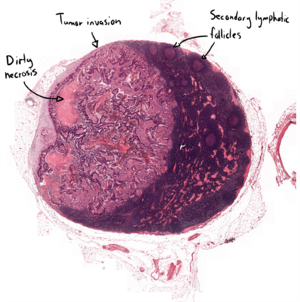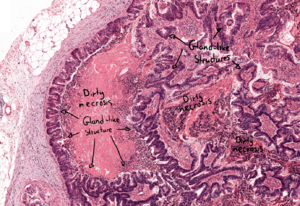37. Adenocarcinoma metastasis in lymph node

Staining: HE
Organ: Lymph node
Description:
With low magnification can we see that the lymph node is divided into two. On the right we have normal lymph node tissue with secondary lymphatic follicles. On the left we have eosinophilic tissue.
With higher magnification can we see that the eosinophilic tissue is comprised of gland-like structures. Some of these structures have necrosis in their lumen.
Diagnosis: Adenocarcinoma metastasis in lymph node
Can originate from:
- Any adenocarcinoma
Theory:

The gland like structures are formed by the cancer cells. These cancer cells are glandular (which is why it is an adenocarcinoma). Because the cancer cells produce such gland-like structures can we say that the cancer is well-differentiated, and therefore low-grade. A poorly differentiated adenocarcinoma would not produce such glandular structures.
The origin of the adenocarcinoma depends on where this lymph node was taken from. However, the necrosis inside the lumen of the glandular structures give us a hint to what the primary site of the cancer was. Necrosis found inside the lumen of these glandular structures is called dirty necrosis and is most commonly found in colorectal adenocarcinomas. This means that this lymph node probably was taken from the lymph nodes that drain the colon. Most likely is this a mesocolic lymph node.
